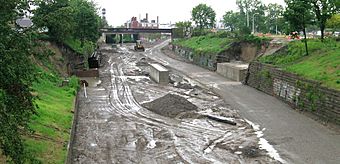Antietam Avenue Bridge facts for kids
Quick facts for kids |
|
|
Antietam Avenue Bridge
|
|

Site of Antietam Avenue bridge after demolition
|
|
| Location | Detroit, Michigan |
|---|---|
| Built | 1930 |
| Architect | Grand Trunk Western Railroad |
| Demolished | c. 2008 |
| MPS | Highway Highway Bridges of Michigan MPS |
| NRHP reference No. | 00000114 |
| Added to NRHP | February 18, 2000 |
The Antietam Avenue Bridge was a bridge in Detroit, Michigan. It used to cross over the Dequindre Cut. This area was once a busy train track owned by the Grand Trunk Western Railroad. The bridge was taken down around 2008 because it was old and not safe anymore. A new bridge is planned to be built in its place. The original bridge was added to the National Register of Historic Places in 2000. This list keeps track of important historical places in the United States.
History of the Bridge
By the 1920s, Detroit was a very busy city. More than 400 factories were working on the east side of the city. But the city's streets were not well planned. Also, large factories were growing, and there were many train tracks. All of this made traffic very slow, especially when people tried to travel from east to west.
In 1923, the city of Detroit and the Grand Trunk Western Railroad decided to fix this problem. They made a plan to build 22 "grade separations." This means they would build bridges or tunnels to separate roads from train tracks. This way, cars and trains would not have to stop for each other. Both the city and the railroad agreed to share the cost of these projects.
One of the train lines that needed these changes ran next to St. Aubin Avenue. These tracks started in the northwest and connected to other train lines. They then went southeast, turning to run alongside the river. These tracks supplied many large factories, like the Detroit-Michigan Stove Plant and the United States Rubber Company Plant. They also served the Parke-Davis Laboratories. The tracks ended at the Brush Street Depot in downtown Detroit.
By March 1930, sixteen of these new crossings were finished. These crossings were part of what is now known as the "Dequindre Cut." The nearby Chestnut Street Bridge was one of them. The Antietam Avenue Bridge was finished soon after. In 1964, the Antietam Avenue Bridge and the Chestnut Street Bridge were used as a one-way pair for traffic.
In the 1980s, the train tracks were no longer used. The ownership of the land changed. As of 2008, the Dequindre Cut is being turned into a special path called a rail trail. This path is used for walking and biking.
Why the Bridge Was Important
The Dequindre Cut area is still in good shape today. From where the Antietam Avenue bridge used to be, you can clearly see how the old train path relates to the city streets. The bridge was a good example of the big effort to separate roads and train tracks in the early 1900s.
However, by 2008, the Antietam Avenue bridge was taken down. It was too old and had structural problems, meaning it was not safe. A new bridge will be built in its place to continue connecting the streets over the Dequindre Cut.

